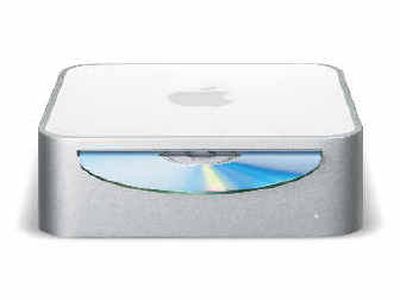Apple’s small wonder

Matthew Williams started thinking about switching to an Apple computer after he fell in love with the company’s iPod digital music player last year, but he found them too pricey.
That has all changed now. The release earlier this month of Apple’s new $499 Mac Mini computer, “is finally the kicker that’s going to bring me to the other side,” says Williams, 21, a student at Morrisville State College in upstate New York.
“After seeing pictures of the Mini, everything else looks bloated,” Williams says of the 2-inch-tall computer.
Demand for the Mini and Apple’s hard-to-come-by new iPod, the $99 Shuffle, has been high at the company’s retail stores.
At the Apple’s Web site, orders are three to four weeks behind on the Mini and Shuffle.
It won’t be the first time Apple has rolled out cool-looking products that are initially hard to get. When the 4-gigabyte iPod Mini hit stores last spring, it took the company four months to meet the demand, Apple Senior Vice President Phil Schiller says.
Once Apple gets its manufacturing into gear, the launch of the Mac Mini — its first budget computer — is expected to pay big dividends for the company, which has been transformed by success of the iPod. Apple has sold 10 million of the trendy digital music players in the last three years, and recently announced its best quarterly performance ever. But in the computer world, Apple is an also-ran.
While creative professionals — designers, photographers, architects and much of the entertainment industry — and other devotees have flocked to Apple computers, 97 percent of personal computer users in the United States prefer Microsoft’s Windows platform.
One big reason is that Mac computers are more expensive. A 15-inch Powerbook laptop starts at $1,999, for instance. A similarly featured Dell sells for about $1,600.
The PC industry is so competitive that many computers sell for slim profits — or even a loss. That creates great deals for consumers, with some retailers offering computer setups for as low as $300, after rebates.
The Mini is being sold without monitor, keyboard and mouse, under the assumption that most people already have them.
By dropping the Mini to $499 for a bare-bones computer, Apple CEO Steve Jobs says customers will now have “no excuse” not to buy a Mac.
Longtime computer industry analyst Roger Kay of market research firm IDC predicts that the Mini will help boost Apple’s computer shipments this year by 50 percent.
Gene Munster, an analyst with securities firm Piper Jaffray, agrees.
“This is the first time Apple has gotten into the mass market game, and it’s going to make a dramatic difference for them,” he says. “The computer hits the sweet spot of what people want — Internet, e-mail, music and digital photos.”
Already, the Mini has hit a real chord on the Internet, where bloggers see it as more than just a device the size of a Cheez-It box. Fill the 40-gigabyte hard drive with music, put it in the trunk and use it to run your auto stereo.
Hook the Mini into a home stereo system, make a few alterations, and you’ve got a digital hub that can tie the TV, music, photos and DVD together.
“I’m really excited about its potential,” says Tom Yager, the technical director for InfoWorld magazine’s test center. “By the time you add the options needed to do these things, you come in at under the sticker price of existing technology.”
Apple’s Schiller cautions consumers not to think of the Mini as anything but a small, second computer or first Mac.
“It’s great that the Mac Mini is inspiring people,” he says. “But that’s not the primary purpose we’re designing it for.”